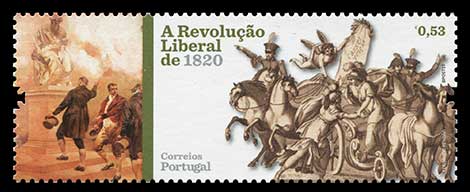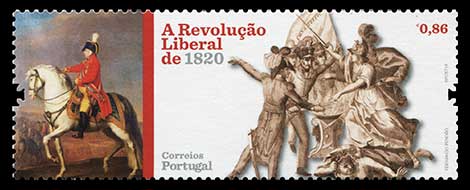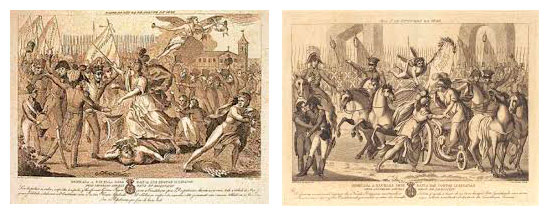
On October 21, 2019, the Portuguese Post issued a series of postage stamps commemorating the Liberal Revolution of 1820.
The Revolution in Portugal of 1820, triggered by the August-September uprisings in Porto and Lisbon, was an important and decisive event in the creation of modern Portuguese constitutionalism. The rise of the revolutionary movement in 1820 was caused by various political and economic factors; by this time, dissatisfaction with the unstable political situation in the kingdom and its dominions was ripe in many layers of Portuguese society.
During the French bourgeois revolution and the Napoleonic wars, Portugal was involved in hostilities on the side of England. In late 1807, after the Portuguese government refused to join the continental blockade, French troops captured Portugal. The king and the court aristocracy fled to Brazil. In June 1808, a popular uprising against the French invaders began in the north of the country, which made it possible for British troops to land on Portuguese territory. In 1808 - 1811. the country was ruled by English and French soldiers, which led to its ruin. With the expulsion of the French from Portugal in 1811, all power passed into the hands of the English marshal, and British officers took key posts in the Portuguese army. The economic development of the country was greatly hampered by the feudal privileges of the aristocracy and the clergy, as well as internal customs duties and numerous monopolies. The economic dependence of Portugal on England had a detrimental effect on the development of industry.
The bourgeoisie and the liberal nobility, the military, the intelligentsia showed increasing dissatisfaction with the feudal order and the dominance of the British. At the head of the revolutionary movement were progressive-minded officers. They demanded the return of King João VI to Lisbon and the early development and adoption of a constitution. In January 1821, the Cortes were convened, which adopted a constitution - the basic law of the state. Among other measures, it provided for the establishment of a State Council under the king, the abolition of feudal privileges, the destruction of the Inquisition, a change in the system of administration and the secularization of church lands. King João VI, who returned to Portugal in July 1821, also swore allegiance to the constitution. After that, Portugal, albeit for a short time, turned into a constitutional monarchy.
In commemoration of the 1820 revolution, the Portuguese post issued two stamps and miniature sheet. The stamps were designed by Fernando Pendão, paintings and prints by Portuguese artists dedicated to the events of that period were chosen as subjects for the stamps. The originals are in the collections of the National Library, the Lisbon Museum, the National Palace of Queluz and the Martins Sarmento Society.

The first stamp of the series, in denomination of 58 cents, is an allegory of the Constitution. It depicts on the left a fragment of the painting "Allegory of Parliamentarians in 1822" by the famous Portuguese artist Columbano Bordalo Pinheiro. On the right is a fragment of an engraving by Constantino de Fontes, based on a painting by artist Antonio Maria da Fonseca.

The second stamp, 86 cents, is an allegory of the Revolution. On the left, it shows an equestrian portrait of King João VI, who inspects the troops in Azambouzh in 1803, by the Portuguese artist Domingos António de Sequeira. On the right, we again see a fragment of an engraving by Constantin de Fontes.

One of the largest collections of engravings dedicated to the 1820 Revolution, including those by Constantin de Fontes, used in the creation of postage stamps, is kept by the Martins Sarmento Society in Guimaraes. This year there was held a thematic exhibition "The Liberal Revolution of 1820 - from the Bastille to the Constitution of 1822", where numerous works of art, graphics and documents were displayed.
Перейти в каталог


